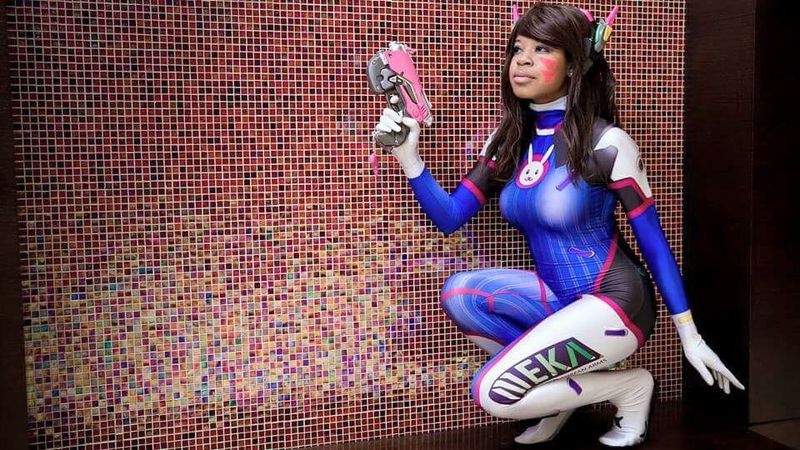
Cosplay has become a cultural phenomenon. We get to partake in the crème de la crème of cosplay on social media. Convention goers are treated to their favorite characters from myriad fandoms coming to life through costuming, makeup, and roleplay. In fact, cosplay has become so pervasive that convention organizers have had to devise rules to enable fans to take pictures of cosplayers without disrupting the rest of the attendees in a given space.
The upper echelon of cosplay is more than just getting to play dress-up. There’s a big difference between buying an off-the-rack costume to wear to a convention and crafting a bespoke cosplay over the course of weeks or months. As a result, there are cosplayers who have taken their craft from hobby to vocation. But it isn’t as lucrative as you may think to be comped a badge to a convention or be paid to attend an event in costume. While there’s the enticing notion of a successful Patreon campaign as a result, making money from cosplay has inherent challenges that many professional cosplayers have to grapple with.
It doesn’t start with how to budget for a full convention season of appearances, either. It starts with the costume itself. Each of the professional cosplayers that I interviewed invest, on average, $500 into the construction of a new cosplay. That $500 covers the costs of materials, like fabric, accessories, wigs, and makeup, but it doesn’t factor in the cosplayer’s own time in making their costumes. Even if they’re not being paid to create the costume, that time still has value.

Any time spent creating a cosplay is time not spent doing paid work, like the freelance copywriting that Ginny DiGuiseppi (Ginny Di to her fans) does in order to pay rent. This valuation on time that’s spent on unpaid work versus paid work is called opportunity cost. Mike Futter, author of the GameDev Business Handbook, defines opportunity cost as “options forgone when you make a choice in allocating resources.”
Calculating the opportunity cost of creating a cosplay from scratch means that there needs to be some kind of dollar amount placed on a cosplayer’s time. Since cosplayer as a vocation isn’t in the Occupational Handbook and its average salary doesn’t exist in places like Glassdoor and Sokanu, I took a look at the next best thing: costume designer. On average, a costume designer makes $36,000 annually, but the starting salary is usually around $18,000, which translates to around $9.40 per hour.
If a professional cosplayer spends approximately 15 hours a week for a month working on their new cosplay, based on the comparable hourly wage of a costume designer, the opportunity cost of a new cosplay is around $560. This doubles the average investment of a from-scratch cosplay to just over $1,000.
Professional cosplayers aren’t just making a single costume a year, either. Ginny Di made 12 in 2017 alone and even though she keeps her material costs low and moves relatively quickly, her costumes with opportunity cost included could still be anywhere from $600 to $1500 apiece. Erica Jones, a professional cosplayer from the UK, who does a few convention appearances each year, creates two new costumes per appearance. Her materials investment is also relatively low, as she makes it habit to never spend more than $275 US on supplies, but the construction still takes time.
“I usually spend a month making two costumes, but again this all ties into patreon and themes, and a bunch of other things,” Jones wrote in an email. “I then have a ‘side’ costume I give a bit more TLC and love. The side costume will usually take like, 3-6 months. When I sit down and it will usually be for about 1-3 hours at a time.”
Krissy Victory, on the other hand, says that she attends “at least 7-8 conventions a year. This year will be around 12, including tournaments. I do one to two new costumes per event.” Victory doesn’t always make her costumes herself, but “cosplay isn’t cheap, whether you’re buying or making.” Her materials investment is on the budget-friendly side, since Victory is a full-time student, but she spends most of her free time on cosplay.
Gabby Nu isn’t new to cosplay, but she is new to the professional side of the coin. “As a regular attendee, I go to at least 7 or 8 cons a year in cosplay. For every con I go to, I always try to bring something new.” At most, Nu spends $400 on materials for a cosplay and can sometimes take 4 months to bring a costume to life. So, with opportunity cost factored in, Nu’s cosplays can cost upwards of $1500.
The cosplays themselves aren’t the only costs involved with being a professional cosplayer, either. There’s also budgeting for the conventions themselves. Many professional cosplayers will have their convention badges comped, which removes that cost, but are expected to pay their own way for transportation, accommodations, and food. According to Victory, there are some conventions that pay a per diem for food, but it isn’t that common.
Traveling to a convention, let alone staying there, can get costly. For cosplay heavy conventions like PAX, DragonCon, and MagFest, cosplayers have to contend with hotels, airfare, the inflated cost of convention food, transportation around the event via Uber, Lyft, or cab, and the cost of transporting their cosplays to events. Many cosplays can be broken down to fit into suitcases, but there are costumes that need unusual shipping materials, like garment boxes, to safely arrive at the convention.
On average, the professional cosplayers I interviewed attend 6 conventions per year. Depending on how far away those conventions are, whether or not accommodations need to be arranged, and how long the convention is, cosplayers can spend anywhere from $200 to $2000 per convention appearance.
Professional cosplayers also need to consider investing in photography. Unless you’ve laid out the money for a professional camera with extra lenses, like Erica Jones has, you’ll need to either become friends with great amateur photographers or be willing to pay for small-scale photoshoots with professionals. The cosplayers I corresponded with were fortunate enough to be able to pay their friends to help them with their Patreon and convention photoshoots, cutting down their costs significantly.
When AshB, a former professional cosplay photographer, attended conventions, she would book photoshoots to offset her cost of attendance. “My shoots started at $100 for a half-hour shoot for up to two people with 4 edited photos of their choice,” she said. “It would cost more if more cosplayers got involved, more time, or more final photos were requested.”
The costumes, the glamour, the dizzying array of followers — from the outside, cosplay appears to be all glitz and big bags of cash to dazzle audiences at conventions. But the numbers tell a different story. It’s expensive, often prohibitively so, to be a professional cosplayer.
Since cosplay has a sky-high price tag, professional cosplayers have to get creative in order to fund their businesses. Many that I chatted with use a combination of Patreon and paid appearances, either on panels or at events, to make enough money to pay their bills and keep their cosplays funded. Most told me that their single source of income is from their cosplay businesses. But there’s a serious discrepancy between adult cosplay and regular cosplay, especially in terms of earning potential on Patreon.
On Patreon, cosplayers offering NSFW (not safe for work) content are included in the “adult” category. In many cases, these photosets are more boudoir than Suicide Girls, which means that the photos are often referred to as “lewd” rather than nude. According to Graphtreon, the top earner in adult cosplay is Jessica Nigiri, a well-known professional cosplayer with an enormous following. Her earnings aren’t available to view but the second top earner, Danielle Beaulieu, makes approximately $16,000 a month from her campaign. Even at the median level, an adult cosplayer on Patreon can make $4,000 a month from a campaign.
But to make that kind of money as a regular “safe for work” cosplayer, you’d have to be at the top of your game. Kinpatsu Cosplay may not share exact numbers for her cosplay Patreon, but she makes more than the second on the list, Moderately Okay Cosplay, who has a $3,300 monthly contribution to his Patreon. On average, however, don’t expect to make more than $1,500 a month from Patreon if you’re not willing to engage in boudoir-style photography.
The difference in earning potential is staggering across the board between NSFW and SFW content on Patreon, but it’s especially palpable in the realms of cosplay.
And as algorithms change on the three major networks (Twitter, Instagram, and Facebook) that many cosplayers use to promote their work, making money as a cosplayer outside of Patreon is almost impossible.
AshB bemoans how professional cosplay appears to be more glitzy than it actually is. “A lot of people try to focus on the numbers that people make in cosplay but they only look at it from the perspective of what’s being earned and not what’s being spent,” AshB told me over Twitter. “You see a lot of young people striving to have a lifestyle that even the people they idolize can barely afford, because it’s all carefully curated Instagram posts and Twitter updates. That’s why you see so much complaining about social media reach because it is detrimental to the small amount of money cosplayers depend on to stay afloat.”

Aspirational lifestyle blogging isn’t new. Fashion bloggers continue to be some of the biggest influencers in the marketplace and cosplay isn’t that far removed from its high fashion cousin. As with any flavor of marketing, aspirational marketing has its dark side. The tweets, Instagram photos, Facebook posts, and Snapchat stories tell a forward-facing tale: being a pro-level cosplayer is something to aspire to. The danger in looking to social media as an accurate reflection of reality is falling victim to Anne Lamott’s contemporary adage of “comparing your insides to everyone else’s outsides.”
Fulfilling Patreon reward tiers, attending conventions, creating cosplays, doing photoshoots, and continuing to grow a business that is quickly hitting the tipping point of inviability can take its toll over the long-term. As with any creative service-based business, there are periods of feast and famine, where the money flows in and then trickles to a halt. But the skills involved in cosplay, including costume design, makeup, photography, social media management, copywriting, and community management, each have career paths of their own and decent average salaries.
Based on the numbers, it’s unreasonable to expect to make a consistent living wage being a professional cosplayer. The investment costs, both in terms of time and materials, cuts into a good chunk of any profit that a pro-level cosplayer can expect to turn. And because of these razor thin margins, as well as the perpetual motion that cosplayers (and internet personalities in general) need to be in to both build and retain audiences, its viability as a long-term, stable business is non-existent.
Cosplay has become an integral part of fandoms across internet culture and that isn’t likely to change. The cosplayers that bring their favorite characters to life through their bespoke costumes do it for the love of the craft and the community. Many of the cosplay pros who make money from this avocation are doing so because it’s a way to be creative and get paid for it.
“I think that’s what’s so great about cosplay – you can choose how much money or time you want to put into it, and what you want to get out of it,” Nu wrote to me over Twitter. “Some people do it 100% as a hobby and have no interest in sponsorships or guesting, some people can completely live off the hobby and turn it into a professional business, and then you have people like me who want to meet somewhere in the middle with it – you really have the freedom to do whatever you want.”
 GameDaily.biz © 2024 | All Rights Reserved.
GameDaily.biz © 2024 | All Rights Reserved.